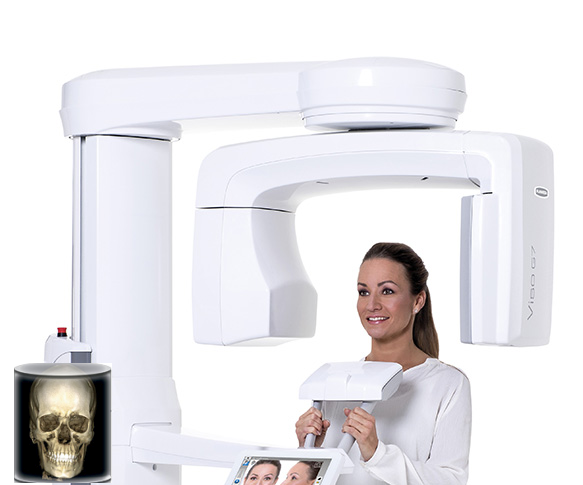Planmeca brings their expertise to CleverHealth Network's AI Head Analysis project focusing on early detection of cerebral hemorrhages
Every year, almost 65 million healthy life years are lost due to cerebral hemorrhage. Planmeca, a founding member in the CleverHealth Network is one of the company partners in the AI Head Analysis project led by Helsinki University Hospital (HUS). The project is looking for new tools for more accurate diagnosis of cerebral hemorrhage. To support the task, the project will develop a machine learning algorithm to help the radiologist and clinicians in the interpretation of computed tomography (CT) images of the head. Planmeca aims to apply the algorithm solution to a more easily accessible cone beam computed tomography (CBCT) scan.
Planmeca, a family business turning 50 years this year, brings to project in-depth knowledge of both algorithms and artificial intelligence.
Finnish Planmeca Oy is one of the world's leading manufacturers of dental equipment. Their products are exported to more than 120 countries. The product range includes digital dental units, CAD/ CAM solutions, state-of-the-art 2D and 3D imaging equipment and supporting software solutions. In the AI Head Analysis project, Vesa Mattila, Vice President, Senior Advisor of Medical Imaging at Planmeca, will help the project in imaging and algorithm productising and commercialisation. The experience gained from Planmeca's extensive in-house distribution network also brings valuable expertise to the global export of the eventual product. Vice President of the Research and Technology Unit Vesa Varjonen and his team will focus on the actual development of AI algorithms. The project at the HUS end is led by Miikka Korja, Chief Innovation Officer and Head of Section at HUS Neurosurgery Unit.
Miikka Korja describes the project as follows:
- “Tens of thousands of different algorithms have been published already in medical research papers, but only a few of them have found the way to clinical use. Together with our company partners we have created in this project a novel AI development infrastructure to HUS. This ensures that the AI algorithms are developed from the early beginning for real clinical needs ending up to practical clinical use and even commercial products. In this field, we at HUS and Finland have an exceptional opportunity to be on top of the world.”
Planmeca is looking forward to delving into data pools and working with top clinicians
According to Vesa Mattila, Planmeca was particularly interested in the data and expert clinicians at the heart of the AI Head Analysis project, as well as HUS's authentic development environment, where projects are created from real needs. The multidisciplinary expertise, networking opportunities and cooperation offered by partner companies are also important to Planmeca. Planmeca is also cooperating more and more with other actors: is not always necessary to know everything by yourself, and this kind of project also provide access to interesting, disruptive views and technologies developed by start-up companies.
Planmeca is also looking for new product areas and growth as part of the ecosystem. Open ecosystems are familiar to Planmeca, as, for example, their software interface is an all-in-one concept, bringing all dental devices behind one user interface. It is also available to competitors' products. The all-in-one solution providing an important daily tool for the dentist is unique in its implementation, similar solutions are not available from other large dental equipment manufacturers.
In the project itself, Planmeca's interest naturally lies in head imaging, but the data contained in the data pool also introduces interesting future prospects.
- Vesa Mattila says: “Planmeca is interested in combining oral health data with general health data and in mining such data in the future. It would be interesting to embark on a path where oral health data would be utilised to support general health information in decision making. We are looking for a future understanding of our own position in the value chain and routes to new paths in the project.” The aim is to expand the possibilities of medical imaging with new products.
Looking for a solution to an industry-wide challenge
When a patient comes to the emergency room complaining of a severe headache, the actual cause is typically analysed from the CT scans. In the worst case, should the cerebral hemorrhage be overlooked and the patient is sent home, the patient may even die. In the AI Head Analysis project, CT images are being used to develop a machine learning algorithm to support the diagnosis of five types of acute cerebral hemorrhage. The aim is to give the radiologist and clinical doctor additional tools that help them make the right diagnosis based on the patient's CT scans.
Currently, the biggest challenges in diagnosis lie in the demanding interpretation of the images and lack of radiology resources. This is emphasized especially in highly focused, hectic emergency duties, reflected also to the work of radiologists on-call at university hospitals. The access to expensive and space-consuming CT imaging equipment is also somewhat poor in some parts of Finland. Cheaper and more compact CBCT devices are widely used, and imaging can be performed in just a few minutes. However, the soft tissue resolution in the CBCT imaging is currently quite not sufficient to detect cerebral hemorrhage.
Planmeca's second goal is to find a solution to improve the soft tissue resolution of the CBCT imaging so that the AI algorithm developed in the project can also be applied to data generated in the CBCT images. The goal is to get the AI-assisted machine learning algorithm to read the imaging result and give an indication for the diagnosis to the clinician in the emergency room. The project is long and ambitious, but when the algorithm is made to work with a more affordable CBCT, the new service is more widely available even in ambulances.
Over the years, Planmeca has gained a lot of expertise in algorithm projects related to machine learning and is now bringing it to the project under the CleverHealth Network. Planmeca’s own expertise has also grown along with the collaboration with researchers — Planmeca has a long history of cooperation with dozens of university hospitals.
- Vesa Varjonen sums up: “The goals and impact of the AI Head Analysis project are considerable: a fast and more cost-effective diagnostic solution can save lives and provide an easier-to-achieve tool for making treatment decisions and help clinicians at emergency units under heavy work-load. There are tremendous future prospects for the business, when CBCT devices can be installed in ambulances and the developed machine learning algorithm can be connected to CBCT devices used at municipal health clinics.”
- 19.06.2024 13:49
CleverHealth Network collaboration between HUS and Fujitsu moves dialysis from hospitals to homes - 06.05.2024 14:27
eMOM project has been completed with promising findings in helping mothers to manage their gestational diabetes - 06.05.2024 13:56
The PHEMS EU project promotes the use of pediatric healthcare data between hospitals - 31.01.2024 11:44
ONCOVALUE project to automate data collection and analytics in assessing real-life effectiveness of cancer care - 26.01.2024 13:33
Impressive results, new ideas and interaction at the CleverHealth Network annual seminar - 02.11.2023 12:35
New remote care solution improves patients' quality of life and brings significant savings to society - 22.09.2023 10:26
A graduate thesis within CleverHealth Network studied the cost-effectiveness of clinical support system for diagnosing vasculitis - 22.08.2023 15:06
Acute leukemia project shows great results in optimizing oncology diagnostic and treatment automation - 22.05.2023 09:24
AstraZeneca joins the CleverHealth Network ecosystem - 03.05.2023 14:47
Tackling pandemics event brings latest results from virus diagnostics to creating health safe spaces - 27.04.2023 09:25
Hewlett Packard Enterprise joins CleverHealth Network - 30.01.2023 10:54
CleverHealth Network ecosystem of digital health innovations yields significant results - 07.12.2022 12:23
Significant EU funding for implementing value-based cancer care at European cancer hospitals - 07.10.2022 09:20
Finnish opera singers contribute to E3 project in detecting differences between people as emitters of aerosols - 10.06.2022 14:28
CleverHealth Network ecosystem and E3 Excellence in Pandemics Response project showcased at HIMSS22 Europe - 18.05.2022 14:25
HUS Acamedic is a certified and scalable virtual research and analytics environment for secure processing of health data - 14.03.2022 09:00
CleverHealth Network showcased at HIMSS Global Health Conference 2022 in March - 17.02.2022 07:37
Novartis is the new partner in the CleverHealth Network ecosystem - 10.12.2021 13:11
Finland must renew its forerunner position in healthcare interoperability - 25.11.2021 14:09
The pandemic boosted the multidisciplinary E3 project on indoor health safety - 11.11.2021 09:51
Telia joins the CleverHealth Network ecosystem - 28.10.2021 10:29
Siemens Healthineers joins the CleverHealth Network collaboration - 04.10.2021 10:43
Fujitsu Finland co-develops a digital service to support treatment of gestational diabetes - 27.05.2021 16:27
Health technology research seeks for tools to support the daily life of dialysis patients and their care personnel - 04.05.2021 17:54
Close collaboration around algorithms in the AI Head Analysis project - 27.04.2021 16:07
Planmeca brings their expertise to CleverHealth Network's AI Head Analysis project focusing on early detection of cerebral hemorrhages - 06.04.2021 10:00
Roche the newest partner of CleverHealth Network - 26.03.2021 16:14
Mobile application to treat gestational diabetes - 01.02.2021 10:30
New preventive care for cardiac disease patients - 21.12.2020 15:00
News on novel initiatives and progress of ecosystem projects were shared at the CleverHealth Network event - 01.12.2020 15:01
Kimmo Porkka's project team harnesses the latest technologies to implement personalised therapies - 05.11.2020 15:30
Smart applications for home dialysis help the daily life of dialysis patients and medical staff - 15.06.2020 15:17
CleverHealth Network ecosystem projects are moving forward - 13.03.2020 13:00
Home dialysis for better quality of life and more efficient treatment - 05.03.2020 15:43
CleverHealth Network projects facilitate diagnostic reliability and improve patient safety - 19.02.2020 15:31
CleverHealth Network wants to start new projects – Pfizer latest partner to join the ecosystem - 27.01.2020 13:00
Fresh media coverage of CleverHealth Network - 24.01.2020 10:49
Networking event in December 2019 was a success - 29.11.2019 13:00
Finnish ecosystem of health innovations continues to grow - 29.08.2019 13:00
CleverHealth Network participated, for the first time, in the HIMSS & Health 2.0 conference organized in Messukeskus, Helsinki 11–13 June 2019. - 10.06.2019 15:00
Digital health innovation ecosystem CleverHealth Network granted Growth Engine status and significant additional funding - 17.04.2019 09:00
Faster and more effective care through artificial intelligence - 28.02.2019 12:45
Aiming for easy and safe remote glucose monitoring for diabetic children - 05.12.2018 15:54
HUS recognised for healthcare IT ecosystem - 01.12.2018 15:00
AI-based diagnostic tool to examine cerebral hemorrhage - 07.03.2018 13:43
AI application for treatment of gestational diabetes - 19.09.2017 17:11
Launching a new ecosystem of digital health innovations

